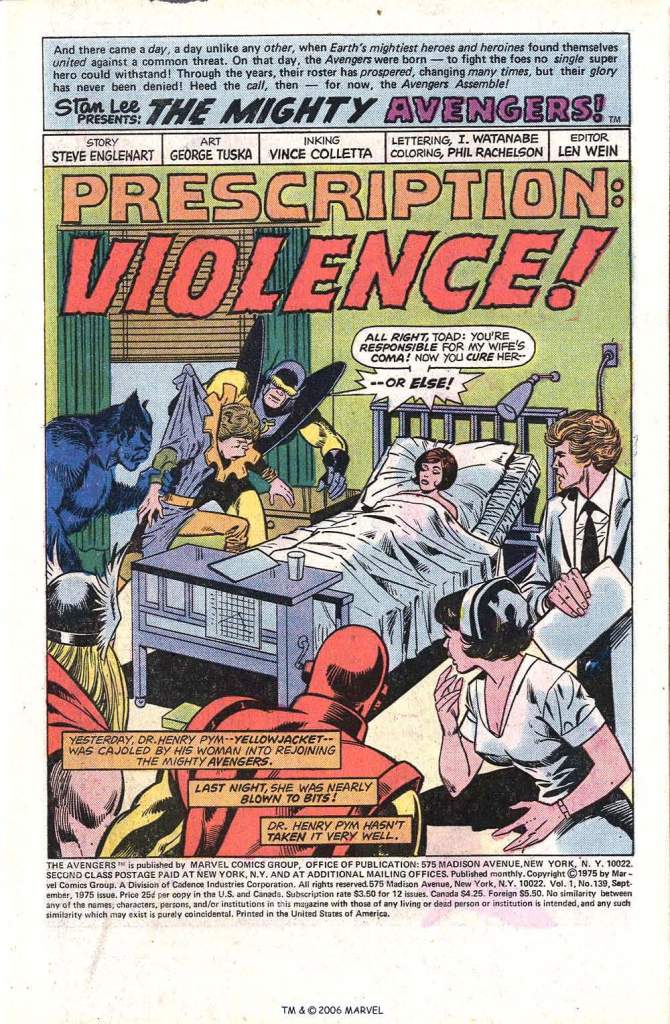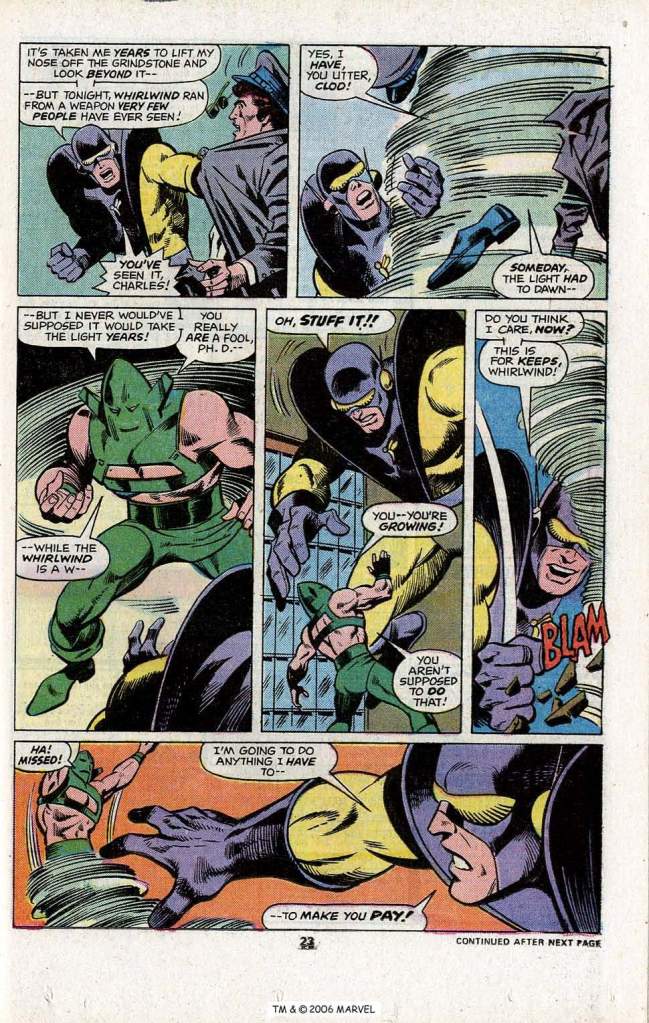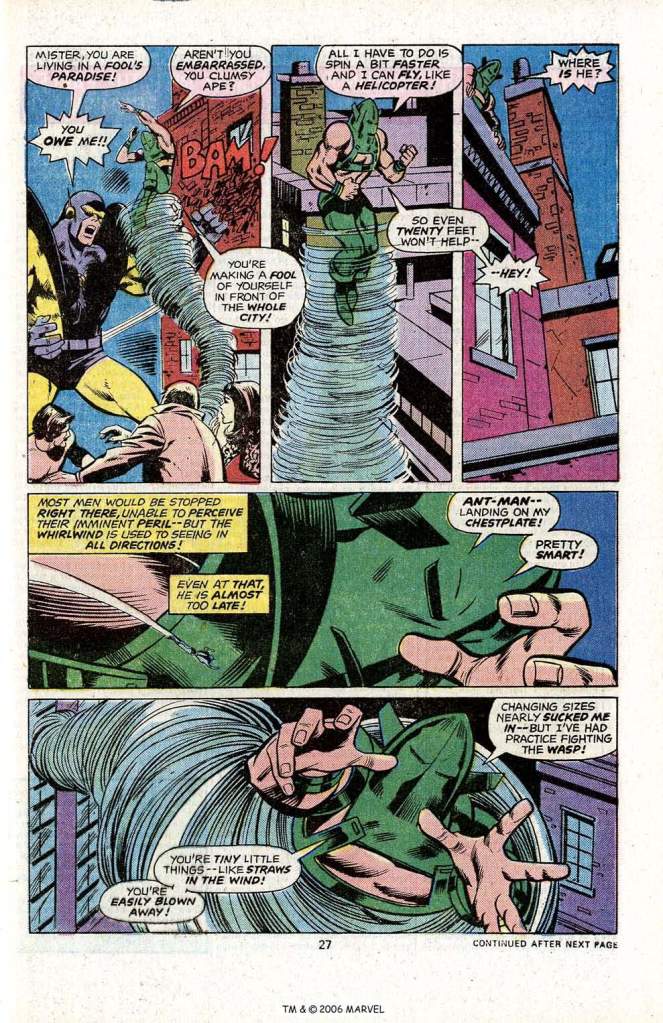
This was another issue of AVENGERS that I dug out of my drug store’s Big Bin of Slightly Older Comics one day, the oldest issue I had yet had an opportunity to read. I had only just taken the plunge into reading AVENGERS–never would I have thought that someday I would not only edit the series, but do so for more than twice the length of time as my nearest competitor. I enjoyed AVENGERS, in particular when things were really clicking in it, but it was never a standout favorite of mine in the way FANTASTIC FOUR was. Still, this is a very nice cover by Gil Kane and John Romita. Romita’s touch was all over the line on covers in this period–even if he didn’t pencil or ink them, he was often called upon by somebody in the editorial chain of command to make corrections to bring characters into line with what they were “supposed” to look like. Consequently, between this and the fact that his work was often used for any licensing needs, John Romita became the face of the house style of Marvel in the 1970s and early 80s.

Within the series at this point, regular writer Steve Englehart was starting up new plotlines after having wrapped up his long-running “Celestial Madonna” storyline a few months earlier. In doing so, he’d shuffled the Avengers line-up a bit, bringing the Beast onto the team. Steve’s first super hero assignment at Marvel was the Beast solo series, and he’d left a bunch of business from it up in the air, so it’s natural that he might include the character among the Avengers. In doing so, he set up a situation where, for readers of a certain age, such as myself, we associate the Beast more with the Avengers than we do with his home series, X-Men–even though he appeared over the years in X-titles a whole lot more often. This is one of those oddities concerning when a particular reader starts following the books. I’m sure that for some people, Jim Rhodes is their Iron Man or John Walker their Captain America in the same way.

AVENGERS wasn’t considered a hugely desirable title in these days. Before teh advent of creator incentives, it required an artist to draw a lot more heroes, a lot more villains, a lot more STUFF–and without any financial upside. Consequently, it tended to be a book that was often fielded by tried-and-true but relatively unexciting pencilers. Here, the art chores are handled by George Tuska, a veteran artist who’d been working since the 1940s. The aforementioned John Romita was a huge fan of his work in the 1940s on CRIME DOES NOT PAY, and he always championed Tuska getting assignments at Marvel. He does a fine job in this issue, albeit one that’s just a little bit “there”. It’s missing that ineffable extra spark of energy that would really propel it to heights. The inking by Vince Colletta in this instance is relatively inoffensive. Vinnie was sometimes called the “great equalizer”–if you had a penciler that was really good or really detailed, he would tend to diminish the energy and complexity of the work in his inks. But if you had a penciler who needed a bit of help in some respect, his work could be additive, bringing everything up to the same approximate level.

So what’s going on in the world of Earth’s Mightiest Heroes? Well, the Wasp lured her husband Yellowjacket back into teh fold during the group’s last roster shake-up–only for Jan to be felled by an explosion immediately thereafter in battle with the Stranger. The Avengers brought the Stranger to heel, only to learn that he wasn’t the true Strange at all–he was the Toad, Magneto’s flunky, who had once been imprisoned along with the Master of Magnetism on the Stranger’s planet and was able to purloin some equipment from it. But none of this does anything to help the injured Wasp, and so Yellowjacket is beginning to lose it. Matters are made worse with the arrival of old nemesis Whirlwind at the hospital. He’d always been obsessed with the Wasp, and here he sees his chance to make off with the injured Jan. The new Avengers manage to drive him off for the moment–in particular, Moondragon, against whose mental powers Whirlwind has no real defense. But as always, he disappears once again in plain sight, resuming his secret identity as “Charles”, the Wasp’s former chauffeur.

Foiled in his attempts to steal away the Wasp, Whirlwind follows Yellowjacket back to his residence and attacks him away from the other Avengers. But YJ is too quick for him, ironically enough–and when the Master of Many Sizes pulls his disruptor pistol on Whirlwind, the villain retreats rather than face it. Which is strange–Whirlwind has never faced this weapon before, should have no idea as to what it does. This leads Hank Pym to give the matter some thought, and he pierces the secret of Whirlwind’s true identity, turning the tables and ambushing the spinning psycho in his own limousine. But that’s not the same thing as vanquishing him, and Yellowjacket is fighting with a drawback: in recent stories, he’d been trapped at ant-size thanks to a microbe in his bloodstream. That microbe is still there, and so every time he makes a size-shift, he’s taking a chance that he might be stricken and perish.

But Yellowjacket has been sitting atop a volcano of rage, regret and pain ever since the Wasp was injured in a battle he feels they shouldn’t have even been a part of, and he’s been looking for an outlet for his anger. So he throws caution to the wind, expanding up to his Giant-Man height despite the danger to himself. Whirlwind is supremely confident despite having been taken by surprise, and Hank isn’t fighting smart, he’s fighting mad, and so he’s not terribly measured in his attacks. But he more than holds his own against the super-swift enemy, putting him on the ropes with the stingers built into his costume. But at the worst possible moment, right when triumph is within his grasp, he suffers another attack from the crippling microbe and, at ant-size, falls from within Whirlwind’s chestplate, helpless.

But just as Whirlwind is about the lower the book, the Beast shows up and knocks him silly. Yellowjacket had phoned the Avengers earlier, and despite his protestations, the Beast headed out to check up on him. Englehart includes a particularly bizarre and almost cryptic reference to a panel from a 1943 episode of the Superman Newspaper Strip in his dialogue. I can’t imagine why, so I feel like this must be an inside joke of some sort. Anyway, Whirlwind is wrapped up and the issue is over. But it was stories like these that made Yellowjacket and Hank Pym seem cool to me. These days it doesn’t happen all that often, but in the more formative years of Marvel, even the characters who were perceived as being a bit stuffy or square would get moments where they would really cut loose as fighters and show what they could do. This was such a showcase for Yellowjacket, and even though he needed the Beast’s help to finish the fight, he still came across quite well in it. Mind you, this is still years before the unfortunate moment where he was depicted as striking the Wasp, a story that all but finished him as a heroic lead, one that he still hasn’t recovered from even after all of this time. But in these days, it was still possible to view Hank Pym as a hero.

The letters page this time out included correspondence from two future comic book figures of note. First came a letter from Dean Mullaney, who would go on to be one of the co-founders of Eclipse Comics in just a couple of years. This was followed by a set of comments from Peter Sanderson, eventually a historian and researcher for both Marvel and DC in the coming years. Their assorted comments about the just-finished Celestial Madonna storyline intrigued the hell out of me. But of course, I didn’t yet have any means with which to read such long-gone glories. That would come in time.

I tend to assume that a lot of what the Beast said back then was just whatever struck Steve as quirky and funny, and served to show Beast as someone of great (and eclectic) range. Maybe Steve had just read that 1943 Superman story, and thought the line was funny, so he used it, figuring that it indicated that the Beast read even things like old comic strips.
LikeLiked by 2 people
I preferred Tuska’s art over some of his peers, like Don Heck, or the artists who drew JLA through most of the 70s. Colletta gets trashed a lot. I’ve seen some bad issues. This isn’t one of them, to me. He seems to tighten up Tuska’s pencilled images enough for them to give them an extra bounce. Reminds me of another artist with a loose, abstract style, the great Gene Golan.
LikeLiked by 1 person
Tuska’s pencils were pretty solid already — I only worked with him once, but scripting from his pencils made me think that the ideal inkers for him would include anyone who inked Colan well.
But Tuska’s storytelling and figure work were so solid that you could have him inked by, say, Mike Esposito, and the result would still be clear, effective comics. So Tuska got inked badly a lot, simply because he could survive it.
When he did get inked well — by Cardy, or Craig, or himself, or that one gorgeous Tuska/Austin job — it was wonderful. Still, I think Tuska/Colletta was a pretty good combination. Tuska’s work was so solid and clear that Colletta softening it didn’t hurt any, and Colletta may have enjoyed it more (or just been naturally simpatico to it) that the combination feels strong and effective. Plus, Colletta usually let Tuska’s amiably cartoony male faces stand, rather than making them more generic.
Not always — I’ve seen Tuska/Colletta pages that look like Vinnie burned through them in five minutes — but these AVENGERS issues were nice, and they did a nice issue of CHAMPIONS and a GHOST RIDER that I remember fondly. If you had to have Colletta ink someone, Tuska was probably the best choice.
LikeLiked by 1 person
Colletta’s feathery ink line definitely works to give the Beast a really hairy, fur-like texture here.
LikeLiked by 1 person
The Superman Newspaper Strip comment from the Beast was rather cryptic, but as a kid I also remember being unfamiliar with the song Whirlwind sings at one point in his chauffeur guise. It wasn’t until 40 years later—after viewing Lerner and Loewe’s Paint Your Wagon on TV in the interim—that I re-read #139 in the Marvel Masterworks edition and finally got the joke. Gotta love that Englehart.
LikeLiked by 1 person
Most definitely a pro’s pro, Colletta took the approach that he’d do great work whenever time allowed. It was in his DNA as an artist and even before that as he was exposed to great art growing up in Sicily. My remembrances of the Tuska/Colletta newspaper strip, World’s Greatest Superheroes are that it was easily the most well-illustrated series in the paper every Sunday. There are so many haters out there who have no idea what it took for Vinnie to ink as many stories as he did. Most of the work that was assigned to him was late due to sloppy editors, slow pencilers, etc. The Kirby people like to point to his erasures, mostly of unimportant and sometimes unnecessary objects, ostensibly to save time. It’s true that Kirby was never late but when Stan, Roy, Shooter or whomever pressed Vince into service to help them meet a deadline, guess which book the editors wanted done first? Despite these grueling assignments, Colletta still managed to create some legendary art. This
one is a really nice collaboration.
LikeLiked by 1 person
Loved, LOVED this issue!!! As an eight year old, it was my first exposure to the inner workings of the Avengers. I still think of the panels where Moondragon has an emotional reaction to the announcement of the new Avengers’ line-up in a newspaper article. That kind of side-drama for me differentiated Marvel from DC and what I enjoyed about the Avengers from then on.
LikeLiked by 1 person
So, explain the joke… What are the qiptrd lines?!
LikeLike